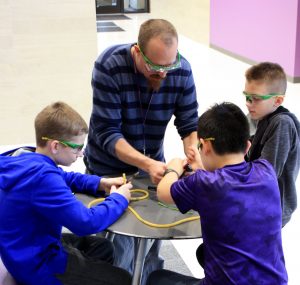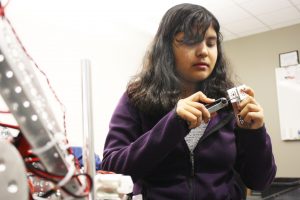Students Gear Up for Robotics Season
The robotics craze has hit schools, libraries, and community groups across the nation. It’s no different in Johnston, with more and more students gearing up to build, program, and compete in a variety of robotic clubs.
As robots make their way into mainstream culture, homes, and lives, there is a need for youngsters to understand just what makes these machines go (and stop, in most cases). Johnston High School art teacher Andrew McCormick has long been a robotics enthusiast and coaches a number of district-supported teams.
“In Johnston, we have two tiers of robotics teams,” said McCormick. “The Johnston Community Education program supports five FIRST Lego League teams, composed of fourth through seventh graders. The district then supports three FIRST Tech Challenge teams for students in grades seven through twelve. It’s a little complicated, but comes down to area youth having a ton of interest in robots.”
FIRST Lego League (FLL)
The FLL teams, supported by Johnston Community Education, are open to younger youth in the area, ideally in grades 4-7. Parent volunteers serve as the coaches and everyone pays a registration fee for the season.
There are currently five FLL teams through JCE. Students study, build, and program robots in the late fall months, then compete at a large regional qualifying tournament in the winter. Last year, Johnston High School hosted a regional tournament and McCormick said area FLL teams will once again return to JHS.
“We have seen – and continue to gain – a lot of interest in FLL,” McCormick said. “Kids are so enthusiastic and by this time in school, have likely had some sort of exposure to robotics programming. FLL provides a great outlet for them to explore a new hobby or build greater skills.”
FIRST Tech Challenge (FTC)

Coach Andrew McCormick works with Mitch Dricoll, Anthony Wang , and Joe Cramer to trim surgical tubing for their competition robot.
For older students, the FTC is a more intensive robotic club. McCormick said that due to high interest and limited resources, students first go through an interview process and are then placed on teams relative to their grade in school. This year, there are teams at JHS, JMS, and SMS, all coached by McCormick and fellow JHS teacher Jennifer Lehman. The teams all practice at JHS.
The FTC competition season runs from September to mid-January, with higher-level competitions taking place after the regular season ends. There are multiple competitions throughout the season; Johnston students are in a league with other metro school districts and typically travel within the metro for their meets.
“There is a lot of potential with the FTC teams,” said McCormick. “Right now, we have more student interest than we have resources in terms of coaches and space. With three teams, we’re comparable to other districts in the metro; we’re also seeing students come back year after year, which helps the depth of skills we have on any given team.”
Other Opportunities
In addition to the community education and district-sponsored teams, there are also some robotics teams that are run solely through individual community members or organizations, such as 4-H clubs. In total, McCormick said there are 69 students who participate in either FLL or FTC through the district and 70 youth who are on a community FLL or FTC team.
Johnston students can also join the Technology Student Association (TSA) when they get to Summit; TSA offers a variety of technology-inspired categories, including one for robotics, for team and individual competition. Johnston has TSA teams at JMS, and JHS. At the high school level, the Hyperstream club has some overlap with FTC, but primarily builds skills in the areas of cyber-security instead of robotics.
“It’s been great to see the district and community respond to a growing interest in robotics and other STEM fields,” said McCormick. “We know there is still more to come and hope to see more resources dedicated to building these programs.”
